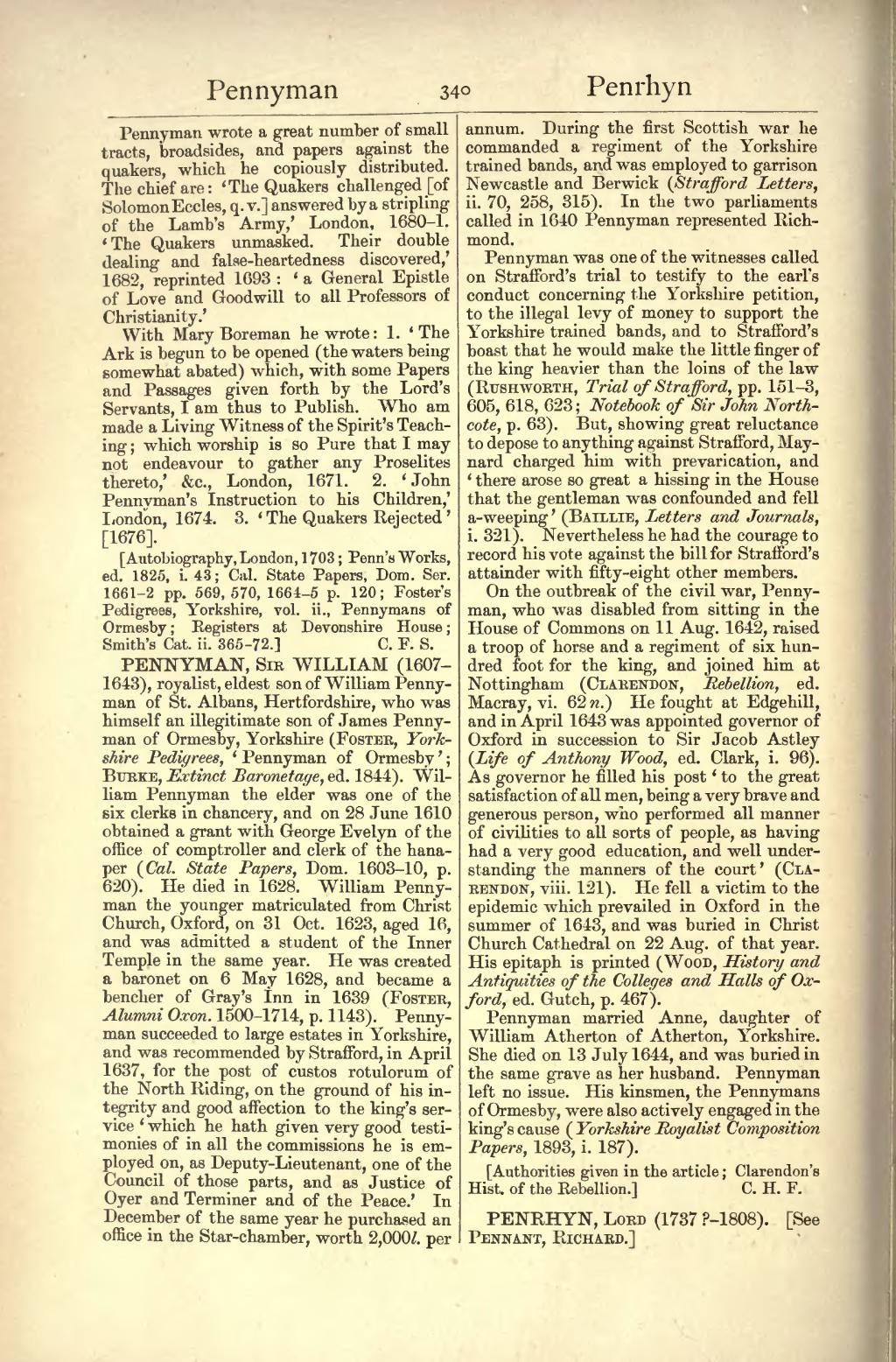Pennyman wrote a great number of small tracts, broadsides, and papers against the quakers, which he copiously distributed. The chief are: ‘The Quakers challenged [of Solomon Eccles, q. v.] answered by a stripling of the Lamb's Army,’ London, 1680–1. ‘The Quakers unmasked. Their double dealing and false-heartedness discovered,’ 1682, reprinted 1693: ‘a General Epistle of Love and Goodwill to all Professors of Christianity.’
With Mary Boreman he wrote: 1. ‘The Ark is begun to be opened (the waters being somewhat abated) which, with some Papers and Passages given forth by the Lord's Servants, I am thus to Publish. Who am made a Living Witness of the Spirit's Teaching; which worship is so Pure that I may not endeavour to gather any Proselites thereto,’ &c., London, 1671. 2. ‘John Pennyman's Instruction to his Children,’ London, 1674. 3. ‘The Quakers Rejected’ [1676].
[Autobiography, London, 1703; Penn's Works, ed. 1825, i. 43; Cal. State Papers, Dom. Ser. 1661–2 pp. 569, 570, 1664–5 p. 120; Foster's Pedigrees, Yorkshire, vol. ii., Pennymans of Ormesby; Registers at Devonshire House; Smith's Cat. ii. 365–72.]
PENNYMAN, Sir WILLIAM (1607–1643), royalist, eldest son of William Pennyman of St. Albans, Hertfordshire, who was himself an illegitimate son of James Pennyman of Ormesby, Yorkshire (Foster, Yorkshire Pedigrees, ‘Pennyman of Ormesby’; Burke, Extinct Baronetage, ed. 1844). William Pennyman the elder was one of the six clerks in chancery, and on 28 June 1610 obtained a grant with George Evelyn of the office of comptroller and clerk of the hanaper (Cal. State Papers, Dom. 1603–10, p. 620). He died in 1628. William Pennyman the younger matriculated from Christ Church, Oxford, on 31 Oct. 1623, aged 16, and was admitted a student of the Inner Temple in the same year. He was created a baronet on 6 May 1628, and became a bencher of Gray's Inn in 1639 (Foster, Alumni Oxon. 1500–1714, p. 1143). Pennyman succeeded to large estates in Yorkshire, and was recommended by Strafford, in April 1637, for the post of custos rotulorum of the North Riding, on the ground of his integrity and good affection to the king's service ‘which he hath given very good testimonies of in all the commissions he is employed on, as Deputy-Lieutenant, one of the Council of those parts, and as Justice of Oyer and Terminer and of the Peace.’ In December of the same year he purchased an office in the Star-chamber, worth 2,000l. per annum. During the first Scottish war he commanded a regiment of the Yorkshire trained bands, and was employed to garrison Newcastle and Berwick (Strafford Letters, ii. 70, 258, 315). In the two parliaments called in 1640 Pennyman represented Richmond.
Pennyman was one of the witnesses called on Strafford's trial to testify to the earl's conduct concerning the Yorkshire petition, to the illegal levy of money to support the Yorkshire trained bands, and to Strafford's boast that he would make the little finger of the king heavier than the loins of the law (Rushworth, Trial of Strafford, pp. 151–3, 605, 618, 623; Notebook of Sir John Northcote, p. 63). But, showing great reluctance to depose to anything against Strafford, Maynard charged him with prevarication, and ‘there arose so great a hissing in the House that the gentleman was confounded and fell a-weeping’ (Baillie, Letters and Journals, i. 321). Nevertheless he had the courage to record his vote against the bill for Strafford's attainder with fifty-eight other members.
On the outbreak of the civil war, Pennyman, who was disabled from sitting in the House of Commons on 11 Aug. 1642, raised a troop of horse and a regiment of six hundred foot for the king, and joined him at Nottingham (Clarendon, Rebellion, ed. Macray, vi. 62 n.) He fought at Edgehill, and in April 1643 was appointed governor of Oxford in succession to Sir Jacob Astley (Life of Anthony Wood, ed. Clark, i. 96). As governor he filled his post ‘to the great satisfaction of all men, being a very brave and generous person, who performed all manner of civilities to all sorts of people, as having had a very good education, and well understanding the manners of the court’ (Clarendon, viii. 121). He fell a victim to the epidemic which prevailed in Oxford in the summer of 1643, and was buried in Christ Church Cathedral on 22 Aug. of that year. His epitaph is printed (Wood, History and Antiquities of the Colleges and Halls of Oxford, ed. Gutch, p. 467).
Pennyman married Anne, daughter of William Atherton of Atherton, Yorkshire. She died on 13 July 1644, and was buried in the same grave as her husband. Pennyman left no issue. His kinsmen, the Pennymans of Ormesby, were also actively engaged in the king's cause (Yorkshire Royalist Composition Papers, 1893, i. 187).
[Authorities given in the article; Clarendon's Hist. of the Rebellion.]
PENRHYN, Lord (1737?–1808). [See Pennant, Richard.]
